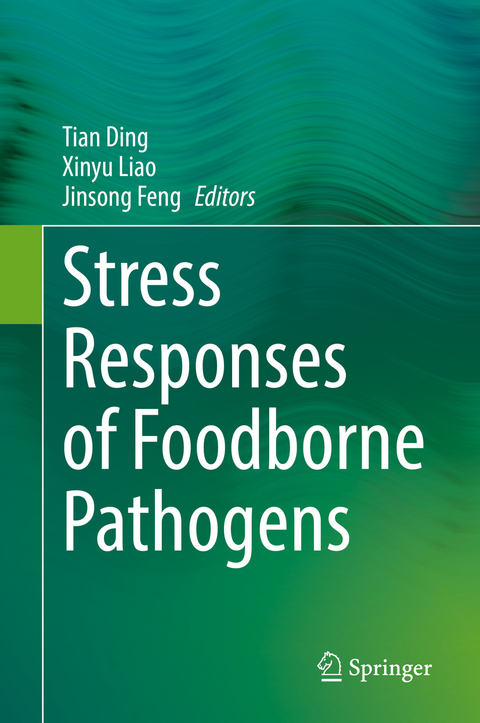
Stress Responses of Foodborne Pathogens
Springer International Publishing (Verlag)
978-3-030-90577-4 (ISBN)
Food-borne bacterial pathogens encounter a number of stressors during food processing and preservation. More and more pathogens are able to adapt their physiological properties and/or genetic expression to survive these stressors and pose a risk to food safety and public health.
This book provides the reader with a comprehensive overview of common food processing-associated stressors (e.g., heat, cold, acid, osmosis, and oxidation) and deals with the molecular basis of the respective bacterial stress response mechanisms (e.g., viable but nonculturable state, biofilm formation, sporulation, and cross-protection response).
Additionally, various chapters cover the response mechanisms of foodborne pathogens to emerging nonthermal sterilisation technologies such as ultrasound, high-pressure processing, pulsed electric fields, ultraviolet light, irradiation and phytochemicals.
Through this book we also learn about future prospects for the efficient control of stressadaption in foodborne pathogens to ensure maximum consumer safety.
This book offers a valuable resource for researchers, graduate students, food process engineers and product developers in the fields of food science and microbiology.
lt;p>Tian Ding is a professor and deputy director at the Institute of Food Engineering in Zhejiang University, China. His research interests include foodborne pathogens, nonthermal technology and microbial risk assessment. Dr. Ding is an associate editor of Food Research International and editorial board member of Food Control, Journal of Food Protection, and Food Science and Human Wellness. He is also a committee member of the Youth Council of Chinese Institute of Food Science and Technology (CIFST), a member of the International Association of Food Protection (IAFP) and the American Society for Microbiology (ASM).
Xinyu Liao is a research assistant in the Department of Food Science and Nutrition, Zhejiang University. Her research focuses on microbial inactivation mechanisms of cold plasma technology as well as the formation of viable but nonculturable (VBNC) Staphylococcus aureus upon cold plasma treatment. So far, Dr. Liao has published over 25 peer-reviewed SCI articles in high-impact journals, including Applied and Environmental Microbiology, Trends in Food Science and Technology, etc. Liao also serves as reviewer for prestigious journals, including Food Research International and Environmental Pollution.
Jinsong Feng is an associate professor at the Department of Food Science and Nutrition, Zhejiang University, China. Dr. Feng got his Ph.D degree at The University of British Columbia. His research interest focuses on the investigation of the influence of commensal microflora on the survival of foodborne pathogens. So far, he has published several papers in prestigious journals, such as Applied and Environmental Microbiology, Trends in Food Science and Technology, and Food Control.
Part I: Introduction.- Chapter 1: The importance of understanding the stress response in foodborne pathogens along the food production chain.- Part II: Response of foodborne pathogens to various food processing-related stressors.- Chapter 2: Response of foodborne pathogens to thermal processing.- Chapter 3: Response of foodborne pathogens to cold stress.- Chapter 4: Response of foodborne pathogens to acid stress.- Chapter 5: Response of foodborne pathogens to osmotic stress.- Chapter 6: Response of foodborne pathogens to oxidative stress.- Part III: Response of foodborne pathogens to emerging nonthermal technologies.- Chapter 7: Response of food-borne pathogens to ultrasound.- Chapter 8: Response of foodborne pathogens to high-pressure processing.- Chapter 9: Response of foodborne pathogens to pulse electric fields.- Chapter 10: Response of foodborne pathogens to cold plasma.- Chapter 11: Response of foodborne pathogens to ultraviolet light.- Chapter 12: Response of foodborne pathogensto irradiation.- Chapter 13: Response of foodborne pathogens for phytochemicals.- Part IV: Stress response mechanisms of foodborne pathogens.- Chapter 14: Viable but nonculturable bacteria.- Chapter 15: Persistence phenotype.- Chapter 16: Biofilm formation of food-borne pathogens.- Chapter 17: Bacterial Spores.- Chapter 18: Sublethally injury adaptation.- Chapter 19: Bacterial Programmed Cell Death.- Chapter 20: Cross-protection response.- Chapter 21: In situ analytical tools to resolve stress response mechanisms of foodborne pathogens.- Part V: Concluding remarks and future prospect.- Chapter 22: Control of the stress response of foodborne pathogens.
| Erscheinungsdatum | 25.04.2022 |
|---|---|
| Zusatzinfo | XIII, 620 p. 116 illus., 98 illus. in color. |
| Verlagsort | Cham |
| Sprache | englisch |
| Maße | 155 x 235 mm |
| Gewicht | 1112 g |
| Themenwelt | Naturwissenschaften ► Biologie ► Mikrobiologie / Immunologie |
| Technik ► Lebensmitteltechnologie | |
| Technik ► Umwelttechnik / Biotechnologie | |
| Schlagworte | Foodborne pathogens • Food Processing • Food Safety • Inactivation efficiency • Microbiology • Stress Adaptation • stressors • Stress response mechanism • Virulence |
| ISBN-10 | 3-030-90577-2 / 3030905772 |
| ISBN-13 | 978-3-030-90577-4 / 9783030905774 |
| Zustand | Neuware |
| Haben Sie eine Frage zum Produkt? |
aus dem Bereich


